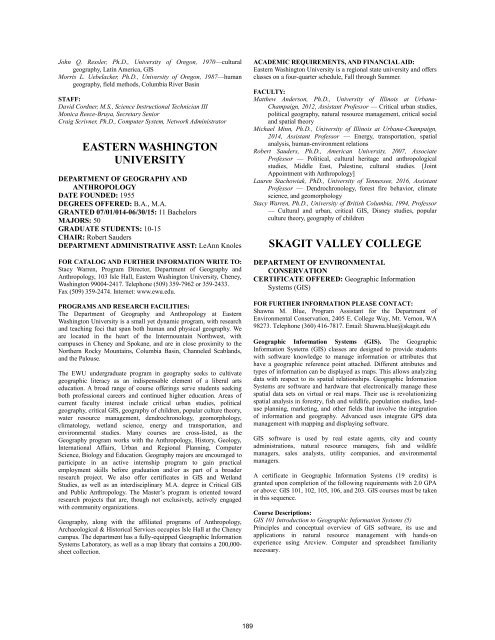AAG
20152016_Guide_to_Geography_Programs_in_the_Americas
20152016_Guide_to_Geography_Programs_in_the_Americas
Create successful ePaper yourself
Turn your PDF publications into a flip-book with our unique Google optimized e-Paper software.
John Q. Ressler, Ph.D., University of Oregon, 1970—cultural<br />
geography, Latin America, GIS<br />
Morris L. Uebelacker, Ph.D., University of Oregon, 1987—human<br />
geography, field methods, Columbia River Basin<br />
STAFF:<br />
David Cordner, M.S., Science Instructional Technician III<br />
Monica Reece-Bruya, Secretary Senior<br />
Craig Scrivner, Ph.D., Computer System, Network Administrator<br />
EASTERN WASHINGTON<br />
UNIVERSITY<br />
DEPARTMENT OF GEOGRAPHY AND<br />
ANTHROPOLOGY<br />
DATE FOUNDED: 1955<br />
DEGREES OFFERED: B.A., M.A.<br />
GRANTED 07/01/014-06/30/15: 11 Bachelors<br />
MAJORS: 50<br />
GRADUATE STUDENTS: 10-15<br />
CHAIR: Robert Sauders<br />
DEPARTMENT ADMINISTRATIVE ASST: LeAnn Knoles<br />
FOR CATALOG AND FURTHER INFORMATION WRITE TO:<br />
Stacy Warren, Program Director, Department of Geography and<br />
Anthropology, 103 Isle Hall, Eastern Washington University, Cheney,<br />
Washington 99004-2417. Telephone (509) 359-7962 or 359-2433.<br />
Fax (509) 359-2474. Internet: www.ewu.edu.<br />
PROGRAMS AND RESEARCH FACILITIES:<br />
The Department of Geography and Anthropology at Eastern<br />
Washington University is a small yet dynamic program, with research<br />
and teaching foci that span both human and physical geography. We<br />
are located in the heart of the Intermountain Northwest, with<br />
campuses in Cheney and Spokane, and are in close proximity to the<br />
Northern Rocky Mountains, Columbia Basin, Channeled Scablands,<br />
and the Palouse.<br />
The EWU undergraduate program in geography seeks to cultivate<br />
geographic literacy as an indispensable element of a liberal arts<br />
education. A broad range of course offerings serve students seeking<br />
both professional careers and continued higher education. Areas of<br />
current faculty interest include critical urban studies, political<br />
geography, critical GIS, geography of children, popular culture theory,<br />
water resource management, dendrochronology, geomorphology,<br />
climatology, wetland science, energy and transportation, and<br />
environmental studies. Many courses are cross-listed, as the<br />
Geography program works with the Anthropology, History, Geology,<br />
International Affairs, Urban and Regional Planning, Computer<br />
Science, Biology and Education. Geography majors are encouraged to<br />
participate in an active internship program to gain practical<br />
employment skills before graduation and/or as part of a broader<br />
research project. We also offer certificates in GIS and Wetland<br />
Studies, as well as an interdisciplinary M.A. degree in Critical GIS<br />
and Public Anthropology. The Master’s program is oriented toward<br />
research projects that are, though not exclusively, actively engaged<br />
with community organizations.<br />
Geography, along with the affiliated programs of Anthropology,<br />
Archaeological & Historical Services occupies Isle Hall at the Cheney<br />
campus. The department has a fully-equipped Geographic Information<br />
Systems Laboratory, as well as a map library that contains a 200,000-<br />
sheet collection.<br />
ACADEMIC REQUIREMENTS, AND FINANCIAL AID:<br />
Eastern Washington University is a regional state university and offers<br />
classes on a four-quarter schedule, Fall through Summer.<br />
FACULTY:<br />
Matthew Anderson, Ph.D., University of Illinois at Urbana-<br />
Champaign, 2012, Assistant Professor — Critical urban studies,<br />
political geography, natural resource management, critical social<br />
and spatial theory<br />
Michael Minn, Ph.D., University of Illinois at Urbana-Champaign,<br />
2014, Assistant Professor — Energy, transportation, spatial<br />
analysis, human-environment relations<br />
Robert Sauders, Ph.D., American University, 2007, Associate<br />
Professor — Political, cultural heritage and anthropological<br />
studies, Middle East, Palestine, cultural studies. [Joint<br />
Appointment with Anthropology]<br />
Lauren Stachowiak, PhD., University of Tennessee, 2016, Assistant<br />
Professor — Dendrochronology, forest fire behavior, climate<br />
science, and geomorphology<br />
Stacy Warren, Ph.D., University of British Columbia, 1994, Professor<br />
— Cultural and urban, critical GIS, Disney studies, popular<br />
culture theory, geography of children<br />
SKAGIT VALLEY COLLEGE<br />
DEPARTMENT OF ENVIRONMENTAL<br />
CONSERVATION<br />
CERTIFICATE OFFERED: Geographic Information<br />
Systems (GIS)<br />
FOR FURTHER INFORMATION PLEASE CONTACT:<br />
Shawna M. Blue, Program Assistant for the Department of<br />
Environmental Conservation, 2405 E. College Way, Mt. Vernon, WA<br />
98273. Telephone (360) 416-7817. Email: Shawna.blue@skagit.edu<br />
Geographic Information Systems (GIS). The Geographic<br />
Information Systems (GIS) classes are designed to provide students<br />
with software knowledge to manage information or attributes that<br />
have a geographic reference point attached. Different attributes and<br />
types of information can be displayed as maps. This allows analyzing<br />
data with respect to its spatial relationships. Geographic Information<br />
Systems are software and hardware that electronically manage these<br />
spatial data sets on virtual or real maps. Their use is revolutionizing<br />
spatial analysis in forestry, fish and wildlife, population studies, landuse<br />
planning, marketing, and other fields that involve the integration<br />
of information and geography. Advanced uses integrate GPS data<br />
management with mapping and displaying software.<br />
GIS software is used by real estate agents, city and county<br />
administrations, natural resource managers, fish and wildlife<br />
managers, sales analysts, utility companies, and environmental<br />
managers.<br />
A certificate in Geographic Information Systems (19 credits) is<br />
granted upon completion of the following requirements with 2.0 GPA<br />
or above: GIS 101, 102, 105, 106, and 203. GIS courses must be taken<br />
in this sequence.<br />
Course Descriptions:<br />
GIS 101 Introduction to Geographic Information Systems (5)<br />
Principles and conceptual overview of GIS software, its use and<br />
applications in natural resource management with hands-on<br />
experience using Arcview. Computer and spreadsheet familiarity<br />
necessary.<br />
189


